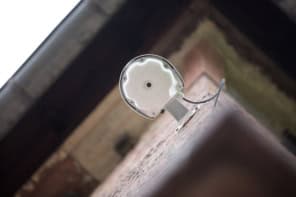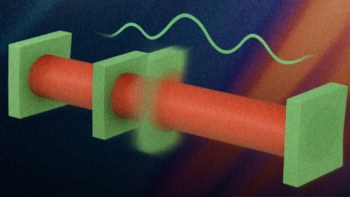
A team of researchers in the Netherlands has developed a new imaging technique that can see through opaque materials – despite the fact that such materials scatter virtually all of the light passing through. Although scientists have previously developed other methods for seeing behind opaque screens, the new scheme does not involve making initial measurements on both sides of the screen. The technique could therefore be used as a non-invasive medical imaging technique to diagnose diseases that lurk under the skin.
Developed by Allard Mosk and colleagues at the MESA+ Institute at the University of Twente, the new imaging system takes advantage of the “speckle pattern” that occurs whenever laser light is fired at a disordered material. Caused by light interfering after being scattered from randomly located molecules or structures in the medium, a speckle pattern may appear random but it actually contains important information about the incident light. In particular, when the angle with which the light strikes the medium is tweaked slightly, the speckle pattern stays more or less the same but shifts by a small angle – called the memory effect.
Speckles stay the same
Rather than simply looking at light that has reflected off an object of interest, Mosk’s team instead examined the light emitted by a hidden object that is fluorescent. This fluorescence is excited by light from a green diode laser that is fired at an opaque screen that obscures the object. The light emerges as speckles on the other side of the screen and this creates a speckled pattern on the object. The bright parts of the pattern create more fluorescent light than the dark regions – and therefore the total intensity of the fluorescent light is proportional to the integral of the speckle pattern over the image area of the object.
If the angle of incidence of the laser is changed, the memory effect causes the speckle pattern to move across the object. The new technique involves changing the angle of incidence while keeping the laser aimed at the same part of the screen. “During the scan we measure the amount of fluorescent light that comes back through the screen,” explains Mosk. Thanks to the memory effect, the team is able to use mathematical manipulation to separate the “autocorrelation” of the speckle pattern – the similarity of successive patterns – and the autocorrelation of the fluorescent light coming from the object. More mathematics is then used to convert this autocorrelation into an image of the object.
Cell-sized object
The team first studied a pi-shaped fluorescent object that measured about 50 μm across (see figure). This size was chosen because it corresponds to that of a typical human cell. The object was placed about 6 mm behind a ground-glass diffuser. To show that the technique also works on biological systems, the team obtained an image of a naturally fluorescent cell from a sample of lily-of-the-valley that was placed between two diffusing screens.
Mosk points out that the technique works best when a relatively thin but high-diffusive screen is used – rather than a thick screen made of less-diffusive material. In the latter case a different technique called optical coherence tomography can obtain better images and he believes that a hybrid of the two methods could be developed to address a wider range of screening materials.
Another possible drawback of the technique is that it only works if the object being studied emits light when illuminated by a laser. While some biological materials are naturally fluorescent, others would have to be labelled with fluorescent molecules. If this is not possible, the technique could work using other light-emitting processes such as nonlinear conversion, Raman scattering or photoacoustics, according to Mosk. “However none of these signals are as strong and as sensitive as fluorescence,” he adds.
Mosk also points out that the technique will not work if the opaque screen itself is strongly fluorescent. “We are planning to use longer-wavelength lasers to avoid this,” he says.
Sylvain Gigan at the Institut Langevin-ESPCI ParisTech says the work is an important breakthrough, even though it is not yet ready for practical biological imaging. “It opens really interesting avenues and I am sure that the idea will have long-lasting consequences and will eventually help develop new imaging techniques,” he says.
The research is described in Nature.



